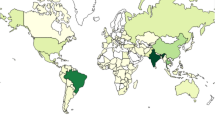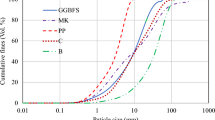Abstract
In this paper; results of the degree of hydration of the pastes and the compressive strength of the 50 mm cubes prepared with the 100% cement and fly ash blended cement were determined. 24 hours after casting mortar cubes and the paste samples were cured for 28 days in the fog room. After 28 days curing, a set of three cubes and a paste sample was dried in the 100%, 75%, 65%, 40% and 12% ambient relative humidity at the constant temperature of 27°C. Drying conditions showed significant effects on the compressive strength and the degree of hydration. Highest compressive strength of 70 MPa was measured of mortar cubes dried in 100% RH; similarly, 97% degree of hydration was obtained for 100% cement samples dried in the 100% RH. For mortar cubes dried in 12% RH, the compressive strength was measured between 47 and 53 MPa. The similar paste samples showed the maximum degree of hydration as 81%. Statistically valid correlations were obtained between the degree of hydration and the compressive strength of normal and blended cement system.
Similar content being viewed by others
References
Alarcan-Ruiz, L., Platret, G., Massieu, E., and Ehrlacher, A. (2005). “The use of thermal analysis in assessing the effect of temperature on a cement paste.” Cement and Concrete Research, Vol. 35, No. 3, pp. 609–613.
ASTM C618-1 (1991). Coal fly ash and raw or calcined natural pozzolan for use as a mineral admixture in concrete, American Society for Testing and Materials.
BS 12 (1991). Specification for portland cement, British Standard Institution.
BS812-103.22 (1989). Testing aggregates. Method for determination of particle size distribution. Sedimentation test, British Standard Institution.
Cabrera, J. G. and Hassan, K. E-G. (1994). “Assessment of the effectiveness of surface treatments against the ingress of chlorides into mortar and concretes.” Corrosion and Protection of Steel in Concrete, International Conference, Sheffield (UK), Swamy, R. N. (Ed.), pp. 1028–1043.
Cabrera, J. G. and Lynsdale, C. J. (1995). “The effect of superplasticisers on the hydration of normal Portland cement.” Proceedings of the international Conference on Advances in Concrete Technology, Las Vegas (USA), pp. 741–751.
Cabrera, J. G. and Lynsdale, C. J. (1996). The effect of superplasticisers on the hydration of normal Portland cement, Cemento, pp. 532–541.
Dweck, J., Buchler, P. M., Coelho, A. C. V., and Cartledge, F. K. (2000). “Hydration of Portland cement blended with calcium carbonate.” Thermochemica Acta, Vol. 346, Nos. 1–2, pp. 105–113.
Jawed, I., Skalny, J., Bach, T., Schubert, P., Bijen, J., Grube, H., Nagataki, S., Ohga, H., and Ward, M. A. (1991). Hardened mortar and concrete with fly ash, RILEM Report, Fly Ash in Concrete: Properties and Performance, Wesche, K. (Ed.).
Keattch, C. J. and Dollimore, D. (1975). Introduction to thermogravimetry, Heydon 45.
Midgley, H G. (1979). “The determination of calcium hydroxide in set Portland cement.” Cement and Concrete Research, Vol. 9, No. 1, pp. 77–82.
Nilsson, L O. (1980). Hygroscopic moisture in concrete — drying, measurement and related material properties, Report, TVBM 1003, Lund Institute of Technology, Lund.
Pipat, T., Toyoharu, N., and Kiyofumi, K. (2006). “Effect of water curing conditions on the hydration degree and compressive strengths of fly ash-cement paste.” Cement & Concrete Composites, Vol. 28, No. 9, pp. 781–789.
Powers, T. C. and Brownyard, T. L. (1948). Studies of the physical properties of hardened Portland cement paste, Research Bulletin No. 22, Portland Cement Association.
Shafiq, N. (1999). Transport characteristics of fluid and ions in concrete: A criteria for concrete durability, PhD Thesis, University of Leeds, UK.
Author information
Authors and Affiliations
Corresponding author
Rights and permissions
About this article
Cite this article
Shafiq, N. Degree of hydration and compressive strength of conditioned samples made of normal and blended cement system. KSCE J Civ Eng 15, 1253–1257 (2011). https://doi.org/10.1007/s12205-011-1193-x
Received:
Revised:
Accepted:
Published:
Issue Date:
DOI: https://doi.org/10.1007/s12205-011-1193-x




